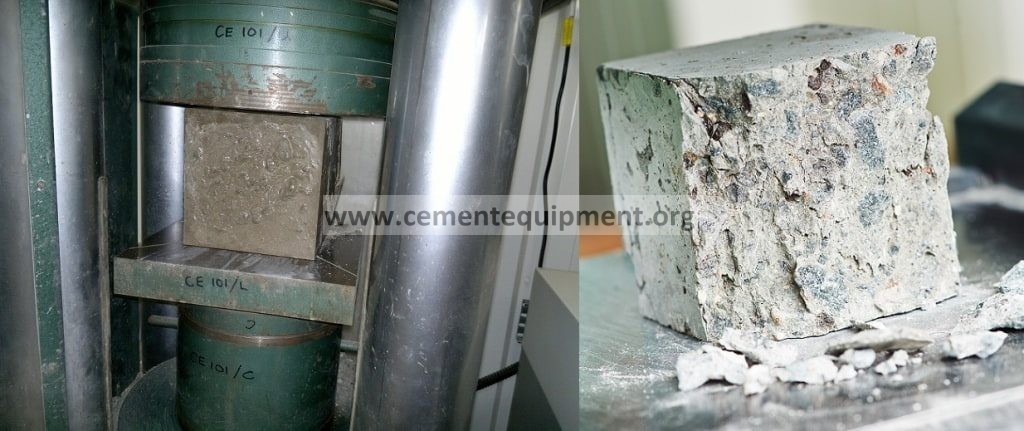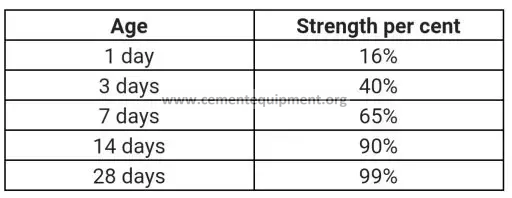Contents
28 days strength

Concrete structures are designed on the basis of 28 days cylinder crushing strength. 28 days cylinder strength actually represents the characteristic strength of the concrete. It is mandatory to test the concrete cylinders at the age of 28 days as per almost all building code requirements.
Concrete has its benefits of strength, availability, durability, flexibility and economy. In case of designing a concrete structure, the compressive strength of concrete is an essential element. 28days compressive strength of concrete is usually considered as the design strength. To ensure this strength it is necessary to wait a considerable time i.e. 28 days. It becomes mandatory because it also represents the quality control process of concrete mixing, placing, compaction, curing etc. Concrete mix design is a process that uses code recommendation and blends with the experience of the concerned engineer. Due to some error in mix design or mix preparation at site the test results may fail to achieve the designed strength, then repetition of the entire process becomes mandatory, which can be costly and time consuming.
what is concrete cure time ?
| how long for concrete to cure how long does it take for concrete to dry? concrete curing time? concrete drying time? what is the percentage of concrete strength gain from 7 to 28 days? how much does concrete strength increase after 28 days |
concrete don’t stop curing. but after period of time which is 28 days , strengthening process will be very slow and neglected less than 1%

what are the major tests of Concrete strength?
- Slump test before leaving the batching plant and on arrival on site.
- Compressive strength test.
- Water Permeability test.
- Rapid Chloride Ion Penetration Test.
- Water Absorption Test.
- Initial Surface Absorption Test.
www.iti.northwestern.edu/cement/monograph/Monograph5_1.html
what is the minimum compressive strength of concrete after 28 days?
Grade of concrete Or characteristic strength of cube fck is characterized by its cube compressive strenght. So cube for M25 grade should show strenght of 25n/mm2 . But when we discuss about acceptance criterion, as per is standard deviation for M25 is 5 as per IS 456-2000.
So acceptance criterion is fck +0.85*sd
= 25 +0.85*5 = 29.25 N/mm^2 .
So your cube should show strenght of 29.25N/mm^2 or 658 KN. Ideally to be within IS permission
what percentage of max strength of concrete after 28 days?
99%
Concrete Strength Calculator ?
kindly check this site
https://www.calculator.net/concrete-calculator.html
what should I do if the precast column that already installed,then the 28days cube test failed?
Any corrective action?
If the 28 day tests fall short of the specified compressive strength, you have a few options to consider.
The first option is to take core samples in accordance with IBC Section 1905.6.6 and ACI 318 Section 5.6.5, which was developed for investigating low-strength test results. After the core samples are analyzed, and you follow the steps in ACI 5.6.3.3, if you are within the 500-psi limit but below the required f’c, you are required to take steps to increase the concrete strength. If you do fall below the 500-psi limit, you have to satisfy the capacity of the structure. The steps are clearly outlined in ACI 5.6.5.
Keep in mind following the steps per ACI is important. While tearing out, replacing and repairing the deficient section sounds like the safest route, ACI procedures should still be followed first. Then, if it is determined the concrete is truly insufficient and a life-safety problem exists, you will have fully documented your steps – identifying and addressing the problem.
The next option is to contact the Structural Engineer of Record for further instruction. If additional 56-day cylinders were cast, tested and achieved the required design strength, it is up to the Structural Engineer of Record whether or not they would accept the 56-day tests as an indication that the concrete has reached its design strength.
Other options to consider:
-Taking additional core samples for analysis
-Performing a load test
-Provide alternatives to repair and strengthen the structure
-Reject the piece and structure altogether”
what factors (like temperature or moisture) effect the curing rate?
Numerous factors affect the rate at which concrete cures, including, but not limited to, the following:
– Ambient temperature at the time of mixing
– Ambient temperature at the time of casting
– Ambient temperature during the curing process
– Temperature of mix water
– Water to cementitious materials ratio (w/cm)
– The mix design’s proportions
– Moisture content of the aggregates
– Any chemical or mineral admixtures used in the concrete mix, including products specifically designed to increase or decrease the rate at which concrete cures
– Any compounds applied to the concrete after casting or stripping
– The chosen method(s) used for curing, which could be accelerated curing by use of applied heat or steam; moist curing; use of tarps, plastic sheeting, or burlap to retain moisture; etc.
– Weather throughout the curing process, including wind, sun, rain or snow
– The product dimensions (thicker sections or mass concrete will take longer to cure than thin sections)
– The type of cement used in the concrete mix